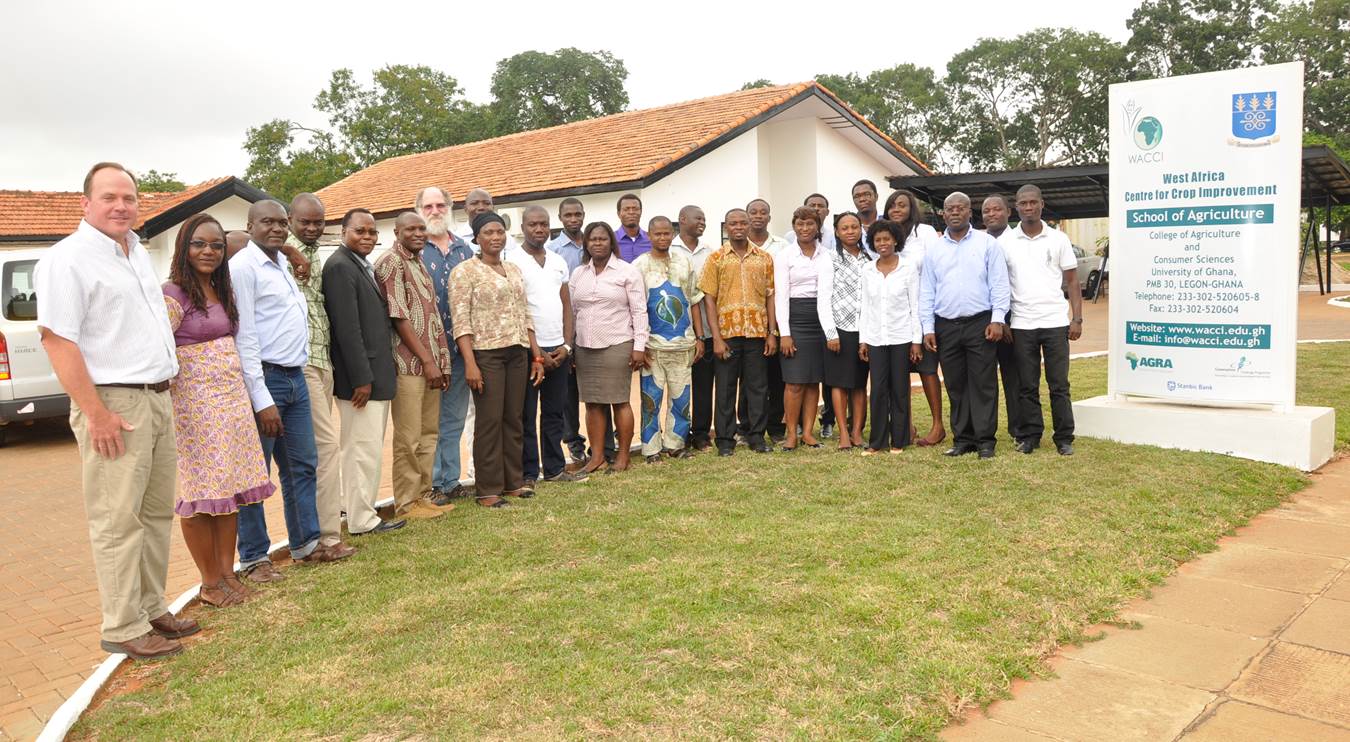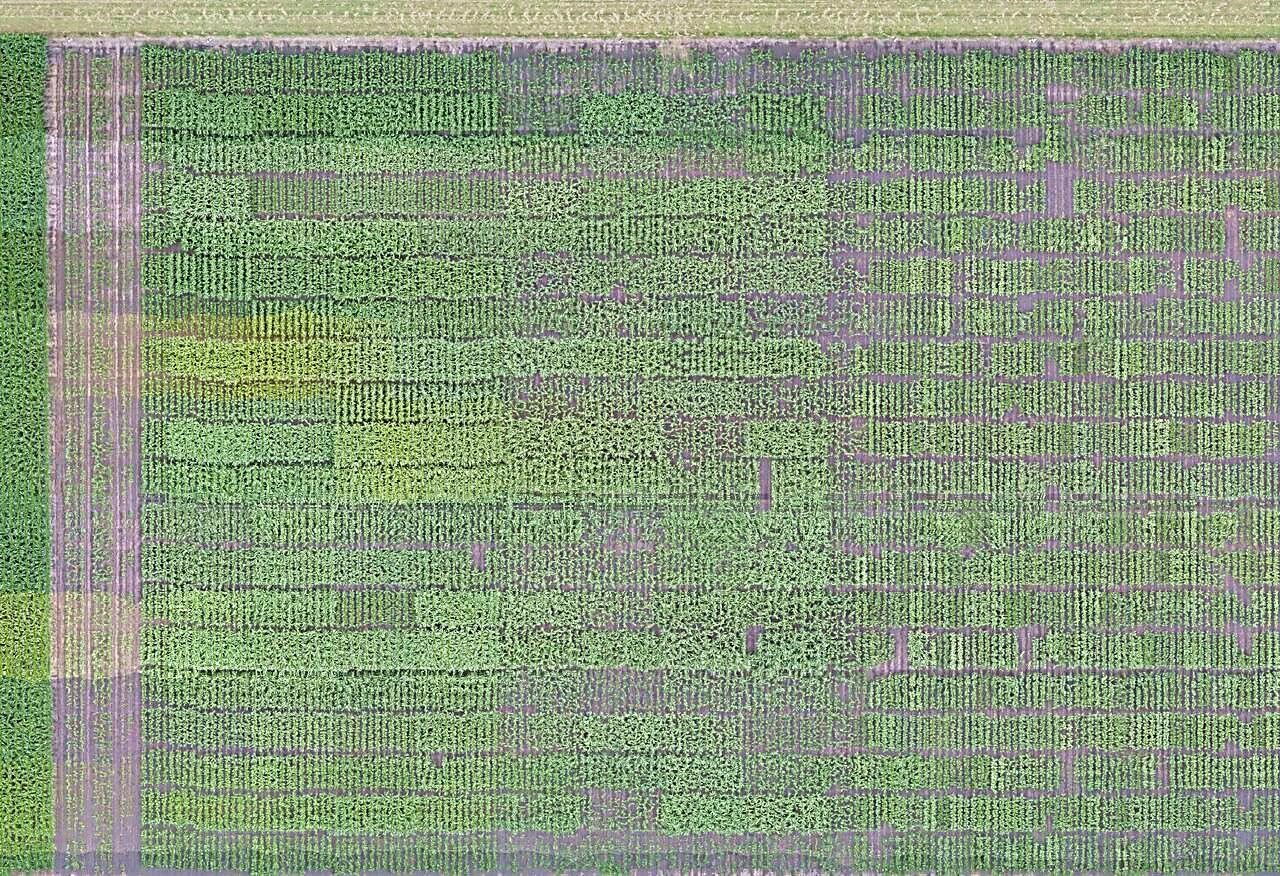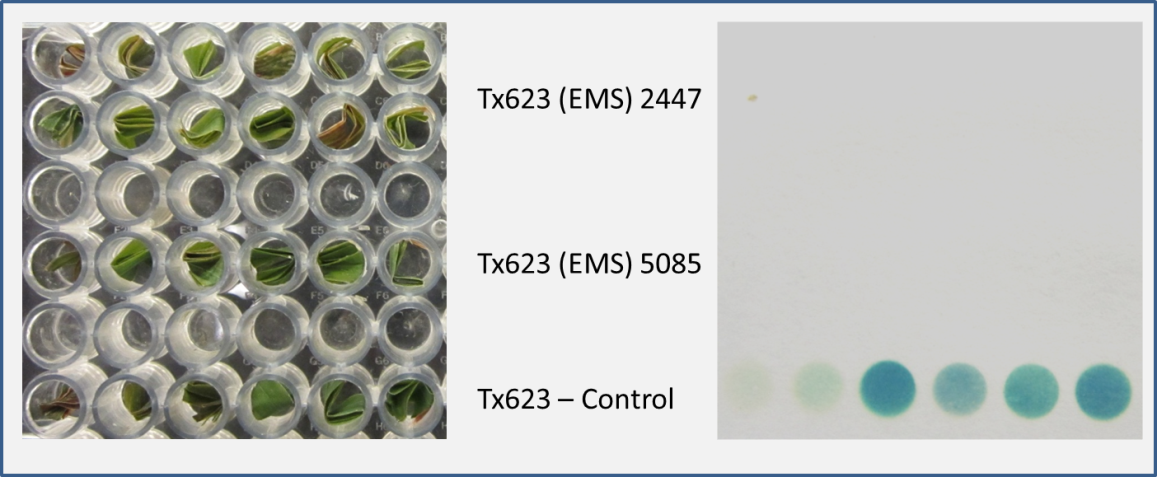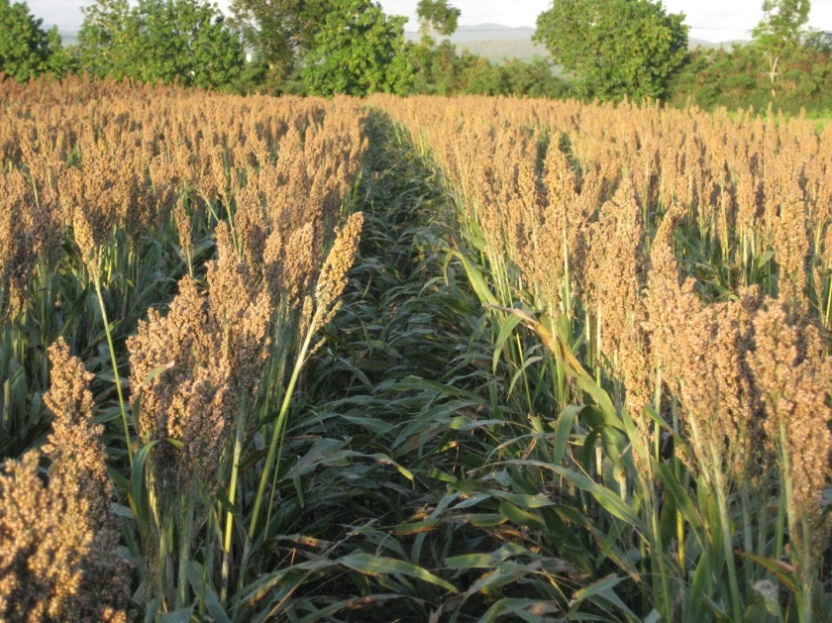Research
Research Areas
Expand the different sections below to learn more about my research.
A sorghum technology developed at Purdue University improves crop and animal safety. Now research confirms that it appeals to the taste buds of grazing ewes.
Sorghum is a resilient forage crop because it tolerates heat and drought. However, it produces the metabolite dhurrin, which breaks down into hydrogen cyanide, a substance also called prussic acid that is toxic to livestock.
A research team led by Mitch Tuinstra, the Wickersham Chair of Excellence in Agricultural Research and professor of plant breeding and genetics in Purdue’s Department of Agronomy, developed the prussic acid-free sorghum that can ease the minds of farmers concerned about feeding forage sorghum to their animals.

The ability of a plant to postpone senescence under late-season drought is commonly defined as 'stay-green'. Stay-green is correlated with enhanced crop productivity, grain quality, and lodging resistance in many crops. Retention of green leaf tissue is known as visual stay-green, whereas functional stay-green is defined by maintenance of photosynthetically active tissue. The goal of our research is to characterize the expression and genetic architecture of stay-green in maize and sorghum. This knowledge will be applied to improving drought tolerance of these and other crops through marker-assisted selection and potentially transgenic approaches.
Maize exhibits substantial genetic variation for stay-green. Joint linkage mapping has been used to identify multiple QTL for stay-green across several linkage groups with sources of stay-green alleles coming from diverse genetic backgrounds. Comparisons between maize and sorghum for map positions of stay-green QTL indicate that two of the major loci occur in syntenous regions. Identification and integration of stay-green genes into commercial programs provides the opportunity to sustainably enhance the productivity of maize and sorghum in drought environments.
 Climate change is forcing changes in agriculture and food production. Increasing temperatures are one of the prominent problems associated with climate change. Heat stress in maize can influence the overall health and production of the crop with yield losses realized through premature senescence of vegetative and reproductive structures. The Heat Tolerant Maize for Asia (HTMA) project is a Global Development Alliance to increase our understanding of heat stress tolerance in maize with partners including CIMMYT, Purdue University, and Pioneer Hi-Bred was well as partners in the National Agricultural Research Systems (NARS) and seed companies from South Asia through the support of USAID. The partners are collaborating in research to understand heat stress tolerance at the physiological and genetic level and to create superior maize hybrids that thrive under these conditions.
Climate change is forcing changes in agriculture and food production. Increasing temperatures are one of the prominent problems associated with climate change. Heat stress in maize can influence the overall health and production of the crop with yield losses realized through premature senescence of vegetative and reproductive structures. The Heat Tolerant Maize for Asia (HTMA) project is a Global Development Alliance to increase our understanding of heat stress tolerance in maize with partners including CIMMYT, Purdue University, and Pioneer Hi-Bred was well as partners in the National Agricultural Research Systems (NARS) and seed companies from South Asia through the support of USAID. The partners are collaborating in research to understand heat stress tolerance at the physiological and genetic level and to create superior maize hybrids that thrive under these conditions.
Tremendous gaps remain in our understanding of the valuable traits contained in sorghum genetic resources. Advances in genomics, targeted mutagenesis, reverse genetics and whole-genome DNA sequencing can enable efficient gene discovery and germplasm mining for crop improvement. With support of the BMGF, we are developing genetic and genomic resources that can be used to leverage the phenotypic variation in sorghum. By developing tools in the genome-sequenced variety BTx623 and elite germplasm adapted for Africa, this project accelerates the ability of sorghum researchers to translate knowledge into practical applications in sorghum improvement.


Using this resource, African breeding programs will identify candidate genes impacting traits of value to them, easily survey alleles of those genes in sequence-indexed collections of EMS mutants and diversity panels of local and globally important lines and landraces. The best alleles for improving their target trait can then be crossed into locally adapted breeding stocks. In addition, African laboratories and breeding programs will be trained in the informatics tools needed to use rapidly expanding and available genomics databases to enable more rapid and more effective sorghum breeding.
 Bottlenecks in our ability to collect accurate, high-resolution, phenotypic data on energy crops such as sorghum limit how efficiently we can combine this information with genomic data to identify, and as necessary modify, the genes and alleles needed to produce superior strains for cultivation. More specifically, enabling the capacity to use sensing data from ground-based mobile and airborne platforms for automated phenotyping would greatly advance plant breeding to maximize energy potential for transportation fuel. Our interdisciplinary team at Purdue University, with support from our industrial partner, IBM Research, and a consultant, Scott Chapman, from the Commonwealth Scientific and Industrial Research Organisation (CSIRO), Australia's national science agency, are developing an automated, high-throughput system, called the Automated Sorghum Phenotyping and Trait Development Platform, which is designed to help end users quantify variations in sorghum field performance and agricultural productivity and detect associations in the sorghum genome. We will develop this disruptive technology system based on airborne and ground-based mobile sensor systems whose accuracy in collecting relevant phenotypic data will be confirmed during development by ground referenced measurements obtained by our phenotyping teams using in situ and near proximal sensors as well as biomass harvester yield data.
Bottlenecks in our ability to collect accurate, high-resolution, phenotypic data on energy crops such as sorghum limit how efficiently we can combine this information with genomic data to identify, and as necessary modify, the genes and alleles needed to produce superior strains for cultivation. More specifically, enabling the capacity to use sensing data from ground-based mobile and airborne platforms for automated phenotyping would greatly advance plant breeding to maximize energy potential for transportation fuel. Our interdisciplinary team at Purdue University, with support from our industrial partner, IBM Research, and a consultant, Scott Chapman, from the Commonwealth Scientific and Industrial Research Organisation (CSIRO), Australia's national science agency, are developing an automated, high-throughput system, called the Automated Sorghum Phenotyping and Trait Development Platform, which is designed to help end users quantify variations in sorghum field performance and agricultural productivity and detect associations in the sorghum genome. We will develop this disruptive technology system based on airborne and ground-based mobile sensor systems whose accuracy in collecting relevant phenotypic data will be confirmed during development by ground referenced measurements obtained by our phenotyping teams using in situ and near proximal sensors as well as biomass harvester yield data.
 A genetic mutant of sorghum that does not accumulate dhurrin was reported by Blomstedt et al. (2012). This mutant was described as a P414L mutation in CYP79A1 but the mutant was reported to grow more slowly than wild-type plants. We have conducted forward genetic screens of a chemically mutagenized sorghum population and identified several new genetic variants that disrupt dhurrin metabolism. Whole genome resequencing experiments demonstrated that one of these variants harbored a C493Y mutation in CYP79A1 that disrupts dhurrin biosynthesis. Plants with this mutation do not exhibit a slow-growth phenotype. This mutation may provide a new genetic resource for eliminating dhurrin production in sorghum to improve feed, forage, and bioenergy feedstock value.
A genetic mutant of sorghum that does not accumulate dhurrin was reported by Blomstedt et al. (2012). This mutant was described as a P414L mutation in CYP79A1 but the mutant was reported to grow more slowly than wild-type plants. We have conducted forward genetic screens of a chemically mutagenized sorghum population and identified several new genetic variants that disrupt dhurrin metabolism. Whole genome resequencing experiments demonstrated that one of these variants harbored a C493Y mutation in CYP79A1 that disrupts dhurrin biosynthesis. Plants with this mutation do not exhibit a slow-growth phenotype. This mutation may provide a new genetic resource for eliminating dhurrin production in sorghum to improve feed, forage, and bioenergy feedstock value.
 Weed management is one of the most important considerations impacting sorghum production today. In Africa, witchweed (Striga spp.) infestations are a growing menace for cereal crop producers across the continent. One new and very promising Striga management technology involves use of herbicide tolerance traits for managing this weed. Low-dose imazapyr or metsulfuron seed coatings applied to herbicide tolerant varieties have been shown to be highly effective in controlling Striga infestation in field and greenhouse trials. Locally-adapted varieties that couple host-plant resistance to Striga with herbicide seed treatments are being developed to identify the combination of traits that maximizes the efficacy of control.
Weed management is one of the most important considerations impacting sorghum production today. In Africa, witchweed (Striga spp.) infestations are a growing menace for cereal crop producers across the continent. One new and very promising Striga management technology involves use of herbicide tolerance traits for managing this weed. Low-dose imazapyr or metsulfuron seed coatings applied to herbicide tolerant varieties have been shown to be highly effective in controlling Striga infestation in field and greenhouse trials. Locally-adapted varieties that couple host-plant resistance to Striga with herbicide seed treatments are being developed to identify the combination of traits that maximizes the efficacy of control.
 Sorghum plant height is a quantitative trait controlled by four major genes (Dw1:Dw2:Dw3:Dw4). Nearly all of the grain sorghum grown in the developed world is produced using semi-dwarf cultivars. These cultivars commonly are called "3-dwarf" sorghum since they utilize recessive dwarfing alleles at three of the four major dwarfing genes (dw1:Dw2:dw3:dw4). Karper (1932) was the first to note that the dw3 mutation produced a useful dwarf phenotype, but also noted that dw3 was unstable and frequently reverted to wild-type Dw3. These plants are tall and generally referred to as "height mutants". Farmers dislike height mutants because these off-types are unsightly in commercial grain production fields. Commercial seed producers do not like height mutants because of the effort and cost required to rogue these plants from seed production fields. These management efforts increase the "cost-of-goods" and, in some cases, seed lots must be destroyed if the frequency of off-types is too high. A novel dw3 allele (dw3-sd2) with a 6-bp deletion in the coding region of gene has been identified. This new allele is being incorporated into elite sorghum parent lines for deployment in commercial hybrids.
Sorghum plant height is a quantitative trait controlled by four major genes (Dw1:Dw2:Dw3:Dw4). Nearly all of the grain sorghum grown in the developed world is produced using semi-dwarf cultivars. These cultivars commonly are called "3-dwarf" sorghum since they utilize recessive dwarfing alleles at three of the four major dwarfing genes (dw1:Dw2:dw3:dw4). Karper (1932) was the first to note that the dw3 mutation produced a useful dwarf phenotype, but also noted that dw3 was unstable and frequently reverted to wild-type Dw3. These plants are tall and generally referred to as "height mutants". Farmers dislike height mutants because these off-types are unsightly in commercial grain production fields. Commercial seed producers do not like height mutants because of the effort and cost required to rogue these plants from seed production fields. These management efforts increase the "cost-of-goods" and, in some cases, seed lots must be destroyed if the frequency of off-types is too high. A novel dw3 allele (dw3-sd2) with a 6-bp deletion in the coding region of gene has been identified. This new allele is being incorporated into elite sorghum parent lines for deployment in commercial hybrids.
